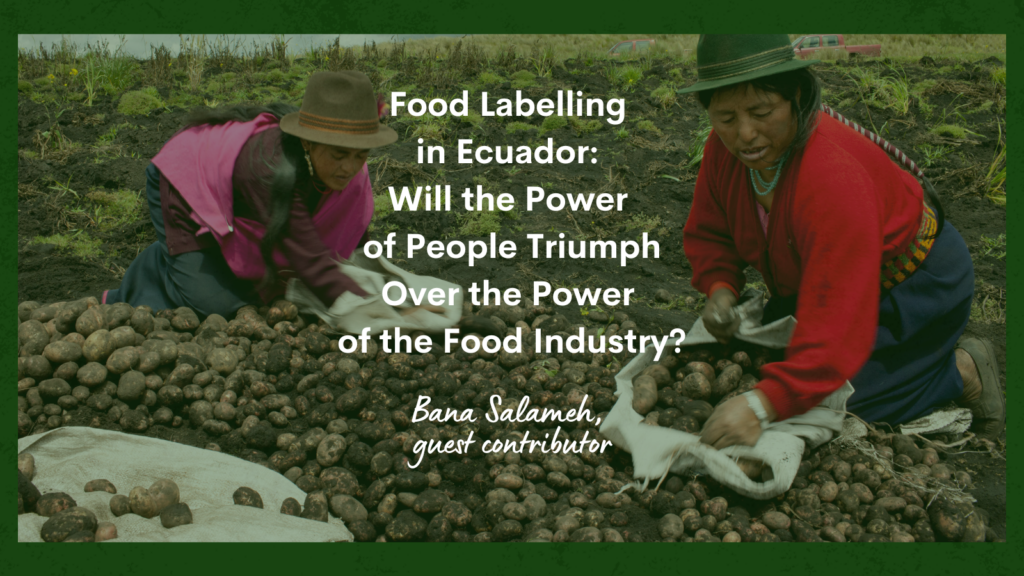Food Labelling in Ecuador: Will the Power of People Triumph Over the Power of the Food Industry?
Civil society efforts have been pushing back against big food industries’ attempts to change a progressive nutrition labelling scheme in Ecuador. This labelling scheme was put in place, along with other measures, to combat the alarming levels of overweight and obesity affecting the entire country. Globalization, modernization, economic growth and urbanization have widely affected people’s lifestyles, the types of foods available and their cost. This has particularly resulted in an increased access to energy-dense, cheap, processed foods that tend to be high in fat, sugar and/or sodium. A national survey done in 2012 estimates that 6 in 10 Ecuadorians, regardless of region, ethnic group or socioeconomic status, are overweight or obese. These
rates, of course, don’t go unaccompanied with a rapid upsurge in associated chronic diseases including diabetes and cardiovascular diseases.

Ecuador’s Public Policy Measures
In response to these rising rates of overweight and obesity, the Ecuadorian government set out a few policies tackling the local food environment. In August 2014, a mandatory “traffic light” food labelling system on all processed foods and beverages was implemented. The idea is that the label presents the amounts of sugar, fat and salt in processed foods using traffic light signals where red indicates high, yellow indicates medium and green indicates low. Evaluation of this system to date shows that it is the clarity, simplicity and attractiveness of this label that renders it a superior tool to assist consumers in making informed health decisions for themselves and their families. Enhanced comprehensibility has proven to be especially important for certain
vulnerable populations including people with low literacy skills, seniors and children. This strategy also acts on a different level as it has provided an incentive for food manufacturers to reformulate some of their products with high concentrations of fat, sugar or salt. Ecuador received international recognition for pioneering this traffic light system in a mandatory manner.

Food Industry Lobbying
What could possibly be a better indicator of a label’s impact on consumption patterns than when certain entities of a profit-oriented food industry oppose it?
Less than two years after the implementation of the traffic light labelling system, challenge from the food industry started emerging, namely from the National Association of Food and Beverage Manufacturers and the Center for the Dairy Industry. They claim that the label is misleading the consumer as it provides limited information. As a result, a new food label was proposed to the government where the words “high”, “medium” and “low” were removed and replaced with percentage daily values and gram amounts for each nutrient. This overload of information dilutes the intended message and defeats the original advantage of simplicity and
attractiveness to the consumer. To further weaken the message, protein content was added to the mix. Although protein is an important nutrient, it is not a public health issue in Ecuador, where only 6% of the population consume inadequate amounts of protein compared to, for example, the 29% exceeding carbohydrate requirements. Bear in mind that consumers have access to detailed nutrition information by using the percentage daily value nutrition label that is still mandatory on all packaged foods and beverages.
Civil Society, National and International Response
It is not every day that various civil society groups and organizations come together to collaborate on behalf of the public’s welfare. However, growing awareness of the effects of industrialized foods coupled with the hypocritical tactics of the food industry triggered a group of activists, which includes the civil-society led food sustainability and sovereignty campaign “¡QUE RICO ES!”, the Agroecological Collective of Ecuador, the Movement for Social and Solidary Economy of Ecuador, and the Amawta Kawsay Slow Food Ecuador, to send an open letter to the president of Ecuador, Rafael Correa Delgado, along with implicated ministers, in efforts to keep the traffic light label.
The response was not limited to local actors; the traffic light label received international support from prominent health organizations including the Pan American Health Organization (PAHO)/the World Health Organization (WHO), the Healthy Latin America Coalition, the International Diabetes Federation, and the National Network for Health Professionals. The Ministry of Public Health in Ecuador is also working relentlessly on keeping this effective guidance tool in order to counteract the trend of ever-rising rates of overweight and obesity.
What will happen next? Will the ability of being informed about the food we consume shift away from the food industry? Are there opportunities for aligning the interests of the industry with those of the public’s health and well-being? Or will it be business-as-usual?
